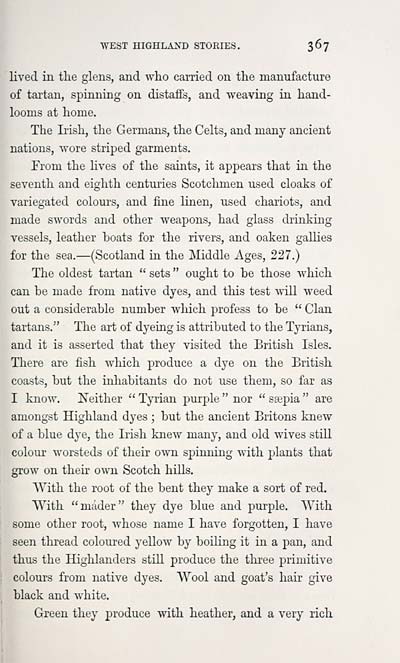Download files
Complete book:
Individual page:
Thumbnail gallery: Grid view | List view

WEST HIGHLAXD STORIES. 367
lived in the glens, and who carried on the manufacture
of tartan, spinning on distaffs, and weaving in hand-
looms at home.
The Ii'ish, the Germans, the Celts, and many ancient
nations, wore striped garments.
From the hves of the saints, it appears that in. the
seventh and eighth centiuies Scotclimen used cloaks of
variegated colours, and fine hnen, used chariots, and
made swords and other weapons, had glass drinking
vessels, leather boats for the rivers, and oaken gallies
for the sea. — (Scotland in the Middle Ages, 227.)
The oldest tartan " sets " ought to be those which
can be made from native dyes, and this test will weed
out a considerable number which profess to be " Clan
tartans." The art of dyeing is attributed to the Tyrians,
and it is asserted that they visited the British Isles.
There are fish which produce a dye on the British
coasts, but the inhabitants do not use them, so far as
I know. Neither " Tyrian purple " nor " sgepia " are
amongst Highland dyes ; but the ancient Britons knew
of a blue dye, the Irish knew many, and old wives stiU
colour worsteds of their own spinning with plants that
grow on their own Scotch hiUs.
With the root of the bent they make a sort of red.
With "mader" they dye blue and purple. With
some other root, whose name I have forgotten, I have
seen thread coloured yellow by boiUng it in a pan, and
thus the Highlanders stiLL produce the three primitive
colours from native dyes. Wool and goat's hair give
black and white.
Green they produce with heather, and a very rich
lived in the glens, and who carried on the manufacture
of tartan, spinning on distaffs, and weaving in hand-
looms at home.
The Ii'ish, the Germans, the Celts, and many ancient
nations, wore striped garments.
From the hves of the saints, it appears that in. the
seventh and eighth centiuies Scotclimen used cloaks of
variegated colours, and fine hnen, used chariots, and
made swords and other weapons, had glass drinking
vessels, leather boats for the rivers, and oaken gallies
for the sea. — (Scotland in the Middle Ages, 227.)
The oldest tartan " sets " ought to be those which
can be made from native dyes, and this test will weed
out a considerable number which profess to be " Clan
tartans." The art of dyeing is attributed to the Tyrians,
and it is asserted that they visited the British Isles.
There are fish which produce a dye on the British
coasts, but the inhabitants do not use them, so far as
I know. Neither " Tyrian purple " nor " sgepia " are
amongst Highland dyes ; but the ancient Britons knew
of a blue dye, the Irish knew many, and old wives stiU
colour worsteds of their own spinning with plants that
grow on their own Scotch hiUs.
With the root of the bent they make a sort of red.
With "mader" they dye blue and purple. With
some other root, whose name I have forgotten, I have
seen thread coloured yellow by boiUng it in a pan, and
thus the Highlanders stiLL produce the three primitive
colours from native dyes. Wool and goat's hair give
black and white.
Green they produce with heather, and a very rich
Set display mode to: Large image | Transcription
Images and transcriptions on this page, including medium image downloads, may be used under the Creative Commons Attribution 4.0 International Licence unless otherwise stated. ![]()
| Early Gaelic Book Collections > Blair Collection > Popular tales of the West Highlands > Volume 4 > (383) |
|---|
| Permanent URL | https://digital.nls.uk/76370287 |
|---|
| Shelfmark | Blair.176 |
|---|---|
| Attribution and copyright: |
|
| Description | Orally collected, with a translation by J.F. Campbell. |
|---|---|
| Shelfmark | Blair.173-176 |
| Additional NLS resources: | |
| Description | A selection of books from a collection of more than 500 titles, mostly on religious and literary topics. Also includes some material dealing with other Celtic languages and societies. Collection created towards the end of the 19th century by Lady Evelyn Stewart Murray. |
|---|
| Description | Selected items from five 'Special and Named Printed Collections'. Includes books in Gaelic and other Celtic languages, works about the Gaels, their languages, literature, culture and history. |
|---|

